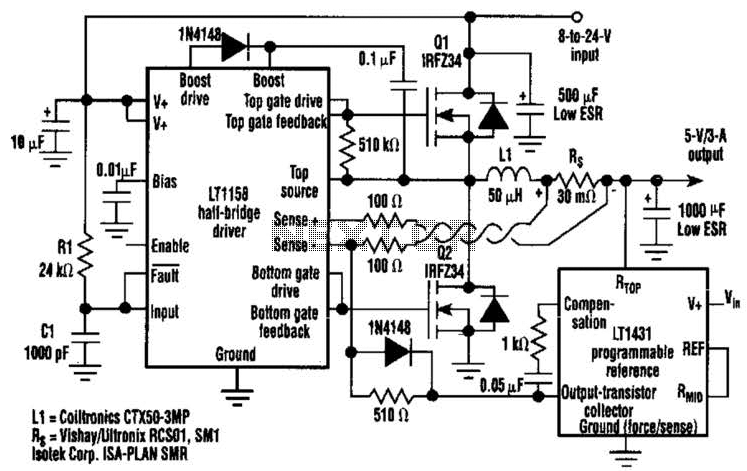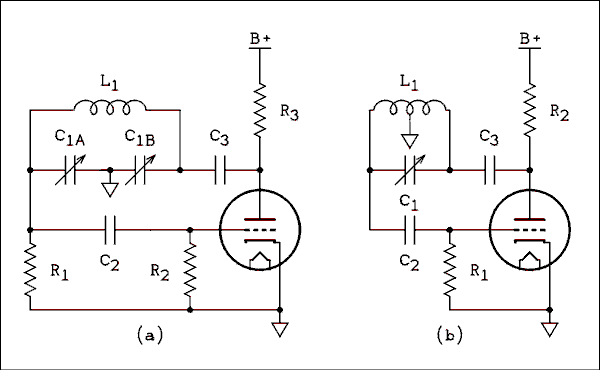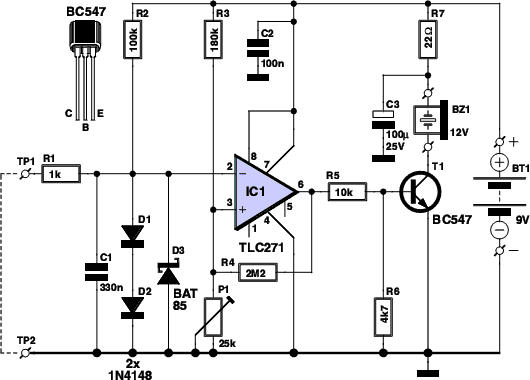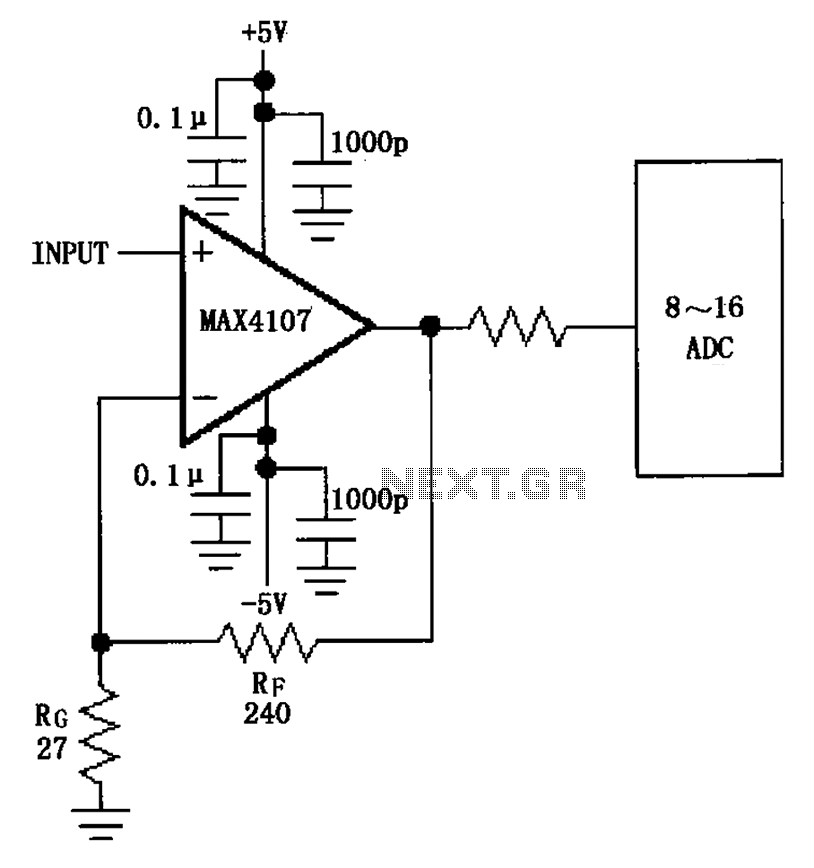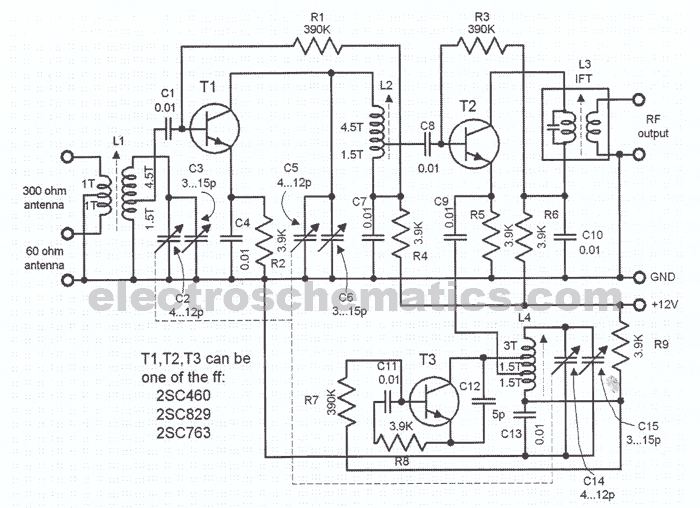
5 division circuit schematic

As illustrated in the dividing circuit diagram, A1 consists of a voltage-controlled current source, A2 functions as a voltage comparator, and A3 is configured as an active low-pass filter. When the time constant R1C1 is equal to the clock pulse period T, the relationship between the output and input of the circuit can be expressed as: Vo = V2E/V1. Therefore, if E is 1V, then Vo = V2/V1, where V1 and V2 are positive values and must be limited to less than 10V, with V2 being slightly lower than V1. The resistors R1, R2, and capacitor C1 must be temperature-stable components. A1 is designated as HA2-2520, while A2 and A3 utilize the LM101A.
The described circuit functions as a voltage divider with specific characteristics and configurations. The voltage-controlled current source (A1) is crucial for adjusting the output current based on the input voltage, allowing for dynamic control of the circuit's behavior. The voltage comparator (A2) plays a critical role in comparing the input voltage levels and providing a digital output signal that indicates whether the input voltage exceeds a certain threshold. This function is essential for applications requiring precise voltage monitoring and control.
The active low-pass filter (A3) is designed to smooth out the output signal from the voltage comparator, thereby reducing high-frequency noise and ensuring a stable output voltage. This filter is particularly important in applications where signal integrity is paramount. The time constant defined by R1 and C1 directly affects the filter's response time, making it vital to select components with stable temperature characteristics to maintain consistent performance across varying environmental conditions.
The relationships between the voltages in the circuit are critical for its operation. The equation Vo = V2E/V1 indicates that the output voltage (Vo) is directly influenced by the ratio of V2 to V1, scaled by the factor E. This relationship allows for predictable behavior of the circuit under different input conditions, making it suitable for a variety of electronic applications.
Overall, the circuit's design, utilizing components such as the HA2-2520 for the voltage-controlled current source and the LM101A for both the voltage comparator and the low-pass filter, ensures reliable operation within specified voltage limits. This configuration is well-suited for applications requiring precise voltage division and filtering in electronic systems. As shown in FIG dividing circuit, A1 composed of a voltage-controlled current source, A2 is a voltage comparator, A3 composition active low pass filter. When the time constant R1C1 equal to the clock pulse period T, the relationship between the output and the input of the circuit is: Vo -V2E/V1, so that if E 1V, there Vo -V2/V1, V1, V2 are positive requirements and limited to less than 10V, V2 is slightly lower than V1. Resistors R1, R2 and capacitor C1 requires a temperature stable element. A1 is HA2-2520, A2, A3 for the LM101A.
The described circuit functions as a voltage divider with specific characteristics and configurations. The voltage-controlled current source (A1) is crucial for adjusting the output current based on the input voltage, allowing for dynamic control of the circuit's behavior. The voltage comparator (A2) plays a critical role in comparing the input voltage levels and providing a digital output signal that indicates whether the input voltage exceeds a certain threshold. This function is essential for applications requiring precise voltage monitoring and control.
The active low-pass filter (A3) is designed to smooth out the output signal from the voltage comparator, thereby reducing high-frequency noise and ensuring a stable output voltage. This filter is particularly important in applications where signal integrity is paramount. The time constant defined by R1 and C1 directly affects the filter's response time, making it vital to select components with stable temperature characteristics to maintain consistent performance across varying environmental conditions.
The relationships between the voltages in the circuit are critical for its operation. The equation Vo = V2E/V1 indicates that the output voltage (Vo) is directly influenced by the ratio of V2 to V1, scaled by the factor E. This relationship allows for predictable behavior of the circuit under different input conditions, making it suitable for a variety of electronic applications.
Overall, the circuit's design, utilizing components such as the HA2-2520 for the voltage-controlled current source and the LM101A for both the voltage comparator and the low-pass filter, ensures reliable operation within specified voltage limits. This configuration is well-suited for applications requiring precise voltage division and filtering in electronic systems. As shown in FIG dividing circuit, A1 composed of a voltage-controlled current source, A2 is a voltage comparator, A3 composition active low pass filter. When the time constant R1C1 equal to the clock pulse period T, the relationship between the output and the input of the circuit is: Vo -V2E/V1, so that if E 1V, there Vo -V2/V1, V1, V2 are positive requirements and limited to less than 10V, V2 is slightly lower than V1. Resistors R1, R2 and capacitor C1 requires a temperature stable element. A1 is HA2-2520, A2, A3 for the LM101A.
